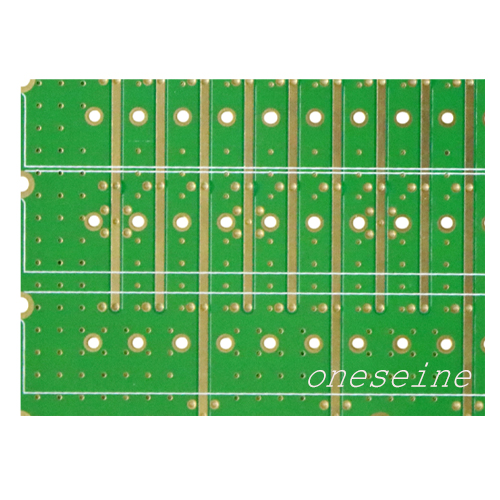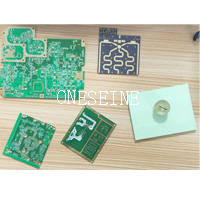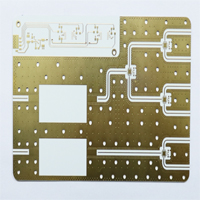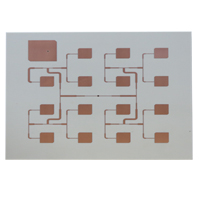Rogers PCB
Rogers 5880 : High Frequency PCB High Quality RT5880 Circuit Board Manufacturing From China
- RT5880
- Rogers 5880
- Rogers RT5880
- Rogers 5880 pcb
- Product description: rt/duroid 5880 thickness duroid 5880 rogers 5880 pcb rogers 5880 price rogers rt5880 rogers 5880 dielectric constant rt/duroid 5880 thickness rt 5880 datasheet rt duroid 5880 price in india r
Rogers 5880 : HIGH FREQUENCY PCB High Quality RT5880 Circuit Board Manufacturing From China
PCB specification:
Brand:Oneseine
Layer:2
Board size:8*6CM
Solder mask:Green
Surface finish:ENIG
Copper:1OZ
What is Rogers PCB ?
Rogers PCBs are specialized printed circuit boards manufactured using high-performance laminates produced by Rogers Corporation. These materials are designed to meet the demanding requirements of high-frequency and high-speed applications, offering superior electrical and mechanical properties compared to standard FR4 materials.
Rogers PCBs have,Low dielectric loss,Consistent electrical properties across a wide range of frequencies,Excellent thermal stability,Low moisture absorption,High reliability in extreme environments
These unique properties make Rogers PCBs ideal for applications in industries such as aerospace, defense, telecommunications, and high-speed computing.
Oneseine is a seasoned manufacturer specializing in Rogers PCBs. Whether you require boards made from pure Rogers material or hybrid lamination, we support high-frequency (HF) PCB projects from the R&D phase through to mass production. If you need design advice or a cost estimate, don’t hesitate to reach out to us! We’re here to assist with your needs.
Specifications of Rogers RT/duroid 5880
Rogers RT/duroid 5880 is a premium high-frequency laminate known for its superior electrical and mechanical properties. Here are its detailed specifications:
Dielectric Constant (Dk): Approximately 2.20 at 10 GHz, ensuring minimal signal distortion.
Dissipation Factor (Df): 0.0009 at 10 GHz, indicative of very low signal loss.
Thermal Coefficient of Dielectric Constant: -125 ppm/°C, providing stable performance over a wide temperature range.
Volume Resistivity: >10^7 MΩ·cm, ensuring excellent insulation and minimal electrical leakage.
Surface Resistivity: >10^6 MΩ, contributing to high surface insulation resistance.
Thermal Conductivity: 0.20 W/m·K, which aids in managing heat dissipation in high-power applications.
Operating Temperature Range: -50°C to +150°C, suitable for extreme environmental conditions.
Water Absorption: <0.02%, ensuring consistent electrical properties even in humid environments.
Peel Strength: ≥7 lb/in (1.23 N/mm), ensuring robust adhesion of copper layers.
Comparison with Other Similar Materials
When compared to other high-frequency laminates, Rogers RT/duroid 5880 stands out due to its combination of low dielectric constant and low dissipation factor. Here’s how it compares to other materials:
Rogers RT/duroid 5880 Substrate Price
Factors Influencing the Price
Several factors influence the price of Rogers RT/duroid 5880 substrates:
Material Composition:
The high-quality PTFE and glass microfiber composition contribute to its superior performance and higher cost.
Thickness and Size: Prices vary based on the thickness and size of the substrate sheets. Thicker and larger sheets typically cost more due to the increased material usage.
Quantity Purchased: Bulk purchases often come with volume discounts, reducing the price per unit compared to smaller orders.
Supplier and Distributor Pricing: Different suppliers and distributors may offer varying prices based on their procurement costs, inventory levels, and market demand.
Market Demand and Supply: Fluctuations in demand, influenced by the tech industry and specific project requirements, can impact pricing. Limited supply or high demand periods can drive prices up.
Customization and Processing Requirements: Custom orders requiring specific processing, such as additional surface treatments or pre-cut sizes, can increase the overall cost.
Additionally, Rogers RT/duroid 5880 exhibits excellent thermal stability and chemical resistance, which allows it to perform reliably in harsh environments. The substrate’s mechanical stability is another significant advantage, providing robust support for intricate circuit designs without compromising performance. The material’s low moisture absorption further ensures consistent electrical properties, even in humid conditions.
Where to Buy (Suppliers and Distributors)
Rogers RT/duroid 5880 substrates can be purchased from various suppliers and distributors. Here are some notable options:
Rogers Corporation: The manufacturer offers direct sales through their website and sales representatives. This is often the best option for ensuring authenticity and access to the latest product lines.
Oneseine Technology:The manufacturer of rogers printed circuit board
Thickness Options for Rogers RT/duroid 5880
Available Thicknesses
Rogers RT/duroid 5880 substrates are available in a range of thicknesses to cater to diverse application requirements. Commonly available thickness options include:
0.005″ (0.127 mm)
0.010″ (0.254 mm)
0.020″ (0.508 mm)
0.031″ (0.787 mm)
0.060″ (1.524 mm)
0.125″ (3.175 mm)
These thicknesses allow designers and engineers to choose the most appropriate substrate for their specific application needs, balancing factors like mechanical stability, signal performance, and space constraints.
Dielectric Constant of Rogers 5880 description:
Importance of Dielectric Constant in Applications
The dielectric constant (Dk) of a substrate material is a critical parameter in the design and performance of high-frequency circuits. It measures the material’s ability to store electrical energy in an electric field and affects various aspects of circuit performance:
Signal Speed and Propagation: The dielectric constant influences the speed at which signals propagate through the substrate. A lower Dk results in faster signal transmission, which is essential for high-speed and high-frequency applications.
Impedance Control: Accurate control of impedance is crucial in RF and microwave circuits to ensure signal integrity and minimize reflection losses. The dielectric constant directly impacts the impedance of transmission lines, necessitating precise material selection for desired impedance values.
Circuit Size: The dielectric constant affects the wavelength of signals within the substrate. A lower Dk allows for smaller circuit elements and more compact designs, which is beneficial in miniaturized and densely packed electronic systems.
Losses and Efficiency: A stable and low dielectric constant reduces dielectric losses, enhancing the overall efficiency of the circuit and ensuring reliable performance in critical applications.
Value of the Dielectric Constant for Rogers 5880
Rogers RT/duroid 5880 has a dielectric constant of approximately 2.20 at 10 GHz. This low Dk value is one of the key features that make it highly suitable for high-frequency and high-performance applications. The consistent and low dielectric constant of Rogers 5880 provides several advantages:
Enhanced Signal Integrity: The low Dk minimizes signal distortion and delays, ensuring clear and accurate signal transmission.
Improved Efficiency: The material’s low dielectric losses contribute to higher circuit efficiency, making it ideal for power-sensitive applications.
Precision in High-Frequency Applications: The stable dielectric constant across a wide frequency range ensures predictable and reliable performance, which is critical for advanced communication systems and high-frequency electronics.
Comparison with Other Materials
When comparing Rogers RT/duroid 5880 with other materials, its low dielectric constant stands out as a significant advantage. Here are some comparisons:
Loss Tangent of RT/duroid 5880
Definition and Significance of Loss Tangent
The loss tangent, also known as the dissipation factor or tan δ, is a measure of a dielectric material’s inherent energy loss when subjected to an alternating electric field. It quantifies the inefficiency with which the material stores and releases electrical energy and is expressed as the ratio of the imaginary part of the permittivity (energy loss) to the real part of the permittivity (energy storage). The lower the loss tangent, the lower the dielectric losses, leading to more efficient signal transmission.
The significance of the loss tangent in high-frequency applications is profound:
Signal Integrity: A low loss tangent minimizes signal attenuation, preserving signal strength and integrity over long distances. This is critical in high-frequency circuits where signal degradation can impact performance.
Efficiency: Materials with a low loss tangent ensure higher efficiency by reducing energy dissipation as heat. This is particularly important in power-sensitive applications and for maintaining the performance of sensitive electronic components.
Thermal Management: Reduced energy loss translates to lower heat generation, which aids in thermal management and enhances the longevity and reliability of electronic devices.
Value for Rogers 5880 and Its Implications
Rogers RT/duroid 5880 is renowned for its exceptionally low loss tangent of approximately 0.0009 at 10 GHz. This low value has significant implications for its performance in high-frequency and high-performance applications:
Enhanced Signal Clarity: The low loss tangent ensures minimal signal loss, maintaining high signal clarity and strength. This is essential for applications such as RF and microwave circuits, where signal quality is paramount.
Higher Efficiency: The minimal energy dissipation translates to higher circuit efficiency, making Rogers 5880 an excellent choice for applications where power efficiency is critical, such as in satellite communication systems and portable electronic devices.
Improved Thermal Performance: With lower dielectric losses, the substrate generates less heat during operation. This reduces the need for extensive thermal management solutions and enhances the overall reliability and lifespan of the electronic components.
Suitability for High-Frequency Applications: The low loss tangent of Rogers 5880 makes it particularly well-suited for high-frequency applications, including radar systems, communication systems, and high-speed digital circuits. The material’s ability to maintain performance at high frequencies ensures that designs can meet stringent requirements for signal integrity and efficiency.
The loss tangent is a crucial parameter that impacts signal integrity, efficiency, and thermal performance in high-frequency applications. Rogers RT/duroid 5880’s exceptionally low loss tangent of approximately 0.0009 at 10 GHz positions it as a superior material for applications demanding minimal signal loss and high efficiency. This characteristic, combined with its low dielectric constant, makes Rogers 5880 an ideal choice for advanced RF and microwave circuits, ensuring reliable and high-performance operation across a wide range of applications.
General Overview of Rogers Substrates
Types of Substrates Offered by Rogers Corporation
Rogers Corporation is a leading provider of high-performance substrates and laminates used in various advanced electronic applications. The company offers a diverse range of substrate materials, each tailored to meet specific performance requirements. Key types of substrates include:
Rogers 5880 material key features and advantages
Rogers Corporation’s substrates are renowned for their exceptional performance characteristics, catering to a wide range of advanced electronic applications. Here are some key features and advantages:
Low Dielectric Constant (Dk):
Many Rogers substrates, like RT/duroid® 5880, have low dielectric constants, which enable faster signal transmission and reduced signal distortion. This is crucial for high-frequency and high-speed applications.
Low Loss Tangent:
Substrates such as RT/duroid® 5880 exhibit low loss tangent values, ensuring minimal signal loss and high efficiency. This feature is vital for maintaining signal integrity in RF and microwave circuits.
Thermal Stability:
Materials like the TMM® series and RO4000® series offer excellent thermal stability, ensuring consistent performance over a wide range of temperatures. This is essential for applications subjected to harsh environmental conditions.
Mechanical Stability:
Rogers substrates provide robust mechanical support, maintaining structural integrity and dimensional stability, which is important for complex circuit designs and multilayer boards.
Chemical Resistance:
Substrates such as RT/duroid® 5880 are chemically resistant, allowing them to perform reliably in corrosive environments and in applications where exposure to chemicals is common.
Wide Range of Dielectric Constants:
Rogers offers a broad spectrum of dielectric constants across its product lines, providing designers with the flexibility to choose materials that best suit their specific performance requirements.
Customization and Versatility:
The availability of various thicknesses and the ability to customize materials for specific applications make Rogers substrates highly versatile, catering to diverse industry needs.
High Frequency Performance:
Many Rogers materials are optimized for high-frequency applications, ensuring reliable performance in RF, microwave, and millimeter-wave frequencies, which is critical for modern communication systems and radar technologies.
Proven Reliability:
Rogers Corporation’s substrates are widely recognized for their reliability and performance, making them a trusted choice for critical applications in aerospace, defense, telecommunications, and medical industries.
Rogers Corporation offers a comprehensive range of high-performance substrates tailored to meet the demands of advanced electronic applications. The key features of these materials, such as low dielectric constant, low loss tangent, thermal and mechanical stability, and chemical resistance, make them ideal for high-frequency, high-speed, and high-reliability applications across various industries.
Applications of Rogers 5880 Substrate
Specific Examples in RF and Microwave Engineering
Rogers RT/duroid 5880 substrates are widely recognized for their exceptional performance in RF and microwave engineering. Here are some specific examples:
Antenna Design:
Phased Array Antennas: RT/duroid 5880 is used in phased array antennas for radar systems, where its low dielectric constant and low loss tangent ensure high efficiency and precise signal propagation.
Patch Antennas: The material’s low dielectric constant allows for smaller, more compact patch antennas with excellent performance in communication systems, including satellite and terrestrial applications.
High-Frequency Circuits:
Power Amplifiers: The substrate’s low loss tangent helps minimize energy dissipation, making it ideal for high-power RF amplifiers used in broadcasting and telecommunications.
Low Noise Amplifiers (LNAs): LNAs benefit from the low loss and stable dielectric properties of RT/duroid 5880, which help maintain signal clarity and reduce noise in sensitive applications like radio astronomy and deep-space communication.
Filters and Couplers:
Microwave Filters: The substrate’s consistent dielectric constant ensures reliable performance in microwave filters, which are critical for separating different frequency bands in communication systems.
Directional Couplers: Used in various RF applications, directional couplers made with RT/duroid 5880 benefit from low insertion loss and stable performance, ensuring efficient signal routing.
Phase Shifters:
Radar Systems: Phase shifters in radar systems use RT/duroid 5880 for its stable dielectric properties, which are essential for precise phase control and accurate target detection and tracking.
Transmission Lines:
Microstrip Lines: The substrate is ideal for microstrip line designs, offering low signal loss and stable impedance characteristics, which are crucial for high-frequency signal transmission.
Stripline Circuits: RT/duroid 5880 is also used in stripline circuits where its low dielectric constant helps achieve controlled impedance and minimal signal distortion.
Other Potential Applications
Beyond RF and microwave engineering, Rogers RT/duroid 5880 substrates find use in a variety of other advanced applications:
Aerospace and Defense:
Avionics Systems: The material’s excellent thermal stability and low loss make it suitable for high-frequency communication and navigation systems in aircraft.
Electronic Warfare: RT/duroid 5880 is used in electronic warfare systems where reliable high-frequency performance is essential for signal jamming and interception technologies.
Medical Devices:
Imaging Systems: The substrate’s low dielectric loss is beneficial in medical imaging equipment like MRI and ultrasound devices, where it helps improve image resolution and clarity.
Implantable Devices: The biocompatibility and stable performance of RT/duroid 5880 make it a suitable choice for implantable medical devices that require high-frequency signal transmission.
Radar Sensors: In advanced driver-assistance systems (ADAS), the material is used in radar sensors for collision avoidance and adaptive cruise control, where its low dielectric constant ensures accurate signal transmission and reception.
Vehicle-to-Everything (V2X) Communication: RT/duroid 5880 supports high-frequency communication systems that enable vehicles to communicate with each other and with infrastructure, enhancing safety and traffic management.
Telecommunications:
Base Stations: The substrate is used in base station antennas and amplifiers for cellular networks, providing reliable performance and efficient signal processing at high frequencies.
5G Technology: RT/duroid 5880’s properties are well-suited for 5G applications, where low loss and high efficiency are critical for high-speed data transmission and low-latency communication.
Satellite Communication:
Transceivers: The material is used in satellite transceivers for its low loss and stable dielectric properties, which are essential for maintaining signal integrity over long distances.
High-Frequency Modules: RT/duroid 5880 is ideal for high-frequency modules in satellite communication systems, ensuring efficient and reliable operation in space environments.
Rogers RT/duroid 5880 substrates are indispensable in a wide range of high-frequency and high-performance applications. Their exceptional dielectric properties, low loss tangent, and thermal stability make them ideal for RF and microwave engineering, as well as aerospace, medical, automotive, telecommunications, and satellite communication systems. These substrates enable precise signal transmission, high efficiency, and reliable performance across diverse and demanding applications.
Signal Integrity:
Thinner Substrates: Thinner substrates, such as 0.005″ and 0.010″, are ideal for high-frequency applications where minimal signal distortion and low insertion loss are critical. These thinner materials help maintain signal integrity by reducing the distance the signal travels through the dielectric material, minimizing phase delay.
Thicker Substrates: Thicker substrates, such as 0.060″ and 0.125″, provide greater mechanical support and are suitable for applications where structural integrity is essential. However, thicker substrates can introduce more signal delay due to the increased distance the signal must travel.
Thermal Management:
Thinner Substrates: Thinner materials have less mass and can dissipate heat more rapidly, which is beneficial in applications where efficient thermal management is required to prevent overheating of components.
Thicker Substrates: While thicker substrates have a greater ability to absorb and spread heat, they may not dissipate it as efficiently as thinner substrates. This can be a consideration in high-power applications where heat buildup needs to be managed.
Mechanical Stability:
Thicker Substrates: Thicker materials provide enhanced mechanical stability, making them suitable for applications involving larger or more complex circuit designs that require robust support to prevent bending or warping.
Thinner Substrates: Thinner substrates are more flexible and can be used in applications where flexibility is required, such as in flexible circuits or in situations where the substrate needs to conform to a specific shape.
Fabrication Considerations:
Thicker Substrates: Thicker substrates may present more challenges during the fabrication process, such as difficulties in drilling and plating through holes. The increased thickness can also affect the alignment and registration of layers in multilayer PCBs.
Thinner Substrates: Thinner substrates are easier to process and are less likely to encounter issues related to drilling and plating. They also offer better layer alignment in multilayer constructions, enhancing overall fabrication accuracy.
Electrical Performance:
Thicker Substrates: Thicker materials may introduce slight variations in the dielectric constant across the substrate’s thickness, potentially affecting the uniformity of electrical performance. However, for many applications, these variations are minimal and do not significantly impact performance.
Thinner Substrates: Thinner substrates tend to have more uniform dielectric properties across their thickness, leading to more consistent electrical performance, which is crucial for high-frequency and high-precision applications.
FAQs About rogers 5880 substrate
What is Rogers RT/duroid 5880 Material?
Rogers RT/duroid 5880 is a high-performance substrate material used in advanced electronic applications. It is a type of PTFE (polytetrafluoroethylene) composite with a glass microfiber reinforcement. This material is designed to offer low dielectric constant and low loss tangent, making it ideal for high-frequency and high-speed applications. Its unique composition provides excellent thermal stability, low signal loss, and high mechanical strength, which are crucial for RF (radio frequency) and microwave circuits.
What is Rogers Substrate?
Rogers substrates are a family of high-performance circuit board materials produced by Rogers Corporation. They are used in a variety of advanced electronic applications, including RF, microwave, and high-speed digital circuits. Rogers substrates are known for their superior electrical properties, including low dielectric constant (Dk), low loss tangent, and excellent thermal stability. They are commonly used in high-frequency applications such as telecommunications, aerospace, and defense systems due to their ability to maintain signal integrity and efficiency in challenging environments.
What is the Dielectric Constant of 5880?
Rogers RT/duroid 5880 has a dielectric constant of approximately 2.20 at 10 GHz. This low dielectric constant helps in achieving faster signal propagation and minimized signal distortion, which is essential for high-speed and high-frequency electronic applications. The material’s stable dielectric constant ensures reliable performance in demanding RF and microwave circuits.
If you want to make RT5880 pcb board,can send gerber file or any other PCB file to our company at any time!
Categories
Latest News
Contact Us
Contact: Ms Tracy
Phone:
Tel:
Add: BludingA,Shixiaganglian Industrial Park,Shajing,Baoan,Shenzhen,China




 Tracy
Tracy